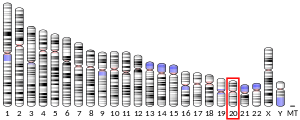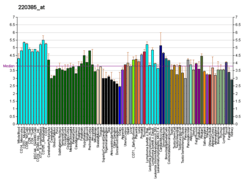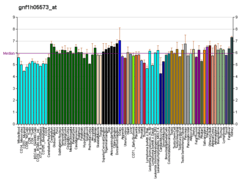JPH2
Junctophilin 2, also known as JPH2, is a protein which in humans is encoded by the JPH2 gene.[5][6][7] Alternative splicing has been observed at this locus and two variants encoding distinct isoforms are described.
Function
Junctional complexes between the plasma membrane and endoplasmic/sarcoplasmic reticulum are a common feature of all excitable cell types and mediate cross talk between cell surface and intracellular ion channels. The protein encoded by this gene is a component of junctional complexes and is composed of a C-terminal hydrophobic segment spanning the endoplasmic/sarcoplasmic reticulum membrane and a remaining cytoplasmic membrane occupation and recognition nexus (MORN) domain that shows specific affinity for the plasma membrane. JPH2 is a member of the junctophilin gene family (the other members of the family are JPH1, JPH3, and JPH4) and is the predominant isoform in cardiac tissue, but is also expressed with JPH1 in skeletal muscle.[8] The JPH2 protein product plays a critical role in maintaining the spacing a geometry of the cardiac dyad - the space between the plasma membrane and sarcoplasmic reticulum.[5] These cardiac dyads also known as junctional membrane complexes or calcium release units are thought to play a key role in calcium induced calcium release by approximating L-type calcium channels on the plasma membrane and ryanodine receptor type 2 on the sarcoplasmic reticulum. JPH2 also contains an evolutionarily conserved nuclear localization signal and a DNA binding domain. During (heart) disease, stress-activated calpain converts the full length JPH2 into fragments. The N-terminal fragment (including nuclear localization signal and DNA binding domain) is translocated to nucleus and regulates gene transcription.[9]
Role in Disease
Mutations in JPH2 were identified in a cohort of patients with hypertrophic cardiomyopathy who lacked the traditional mutations in sarcomere proteins.[10] JPH2 has been shown to be downregulated in several animal models of heart failure. A JPH2 knock-out mouse model is lethal at embryonic day 10.5, which is around the time when cardiac contractility should initiate. These mice showed abnormal cardiac calcium handling, cardiomyopathy, and altered junctional membrane complex formation.
References
- GRCh38: Ensembl release 89: ENSG00000149596 - Ensembl, May 2017
- GRCm38: Ensembl release 89: ENSMUSG00000017817 - Ensembl, May 2017
- "Human PubMed Reference:". National Center for Biotechnology Information, U.S. National Library of Medicine.
- "Mouse PubMed Reference:". National Center for Biotechnology Information, U.S. National Library of Medicine.
- "Entrez Gene: JPH2 junctophilin 2".
- Takeshima H, Komazaki S, Nishi M, Iino M, Kangawa K (July 2000). "Junctophilins: a novel family of junctional membrane complex proteins". Mol. Cell. 6 (1): 11–22. doi:10.1016/S1097-2765(05)00005-5. PMID 10949023.
- Nishi M, Mizushima A, Nakagawara K, Takeshima H (July 2000). "Characterization of human junctophilin subtype genes". Biochem. Biophys. Res. Commun. 273 (3): 920–7. doi:10.1006/bbrc.2000.3011. PMID 10891348.
- Garbino A, van Oort RJ, et al. (2009). "Molecular evolution of the junctophilin gene family". Physiol Genomics. 37 (3): 175–86. doi:10.1152/physiolgenomics.00017.2009. PMC 2685503. PMID 19318539.
- Guo A, Wang Y, et al. (2018). "E-C coupling structural protein junctophilin-2 encodes a stress-adaptive transcription regulator". Science. 362 (6421). doi:10.1126/science.aan3303. PMC 6336677. PMID 30409805.
- Landstrom AP, Weisleder N, et al. (2007). "Mutations in JPH2-encoded junctophilin-2 associated with hypertrophic cardiomyopathy in humans". J Mol Cell Cardiol. 42 (6): 1026–35. doi:10.1016/j.yjmcc.2007.04.006. PMC 4318564. PMID 17509612.
Further reading
- Nishi M, Mizushima A, Nakagawara K, Takeshima H (2000). "Characterization of human junctophilin subtype genes". Biochem. Biophys. Res. Commun. 273 (3): 920–7. doi:10.1006/bbrc.2000.3011. PMID 10891348.
- Takeshima H, Komazaki S, Nishi M, et al. (2000). "Junctophilins: a novel family of junctional membrane complex proteins". Mol. Cell. 6 (1): 11–22. doi:10.1016/S1097-2765(05)00005-5. PMID 10949023.
- Deloukas P, Matthews LH, Ashurst J, et al. (2002). "The DNA sequence and comparative analysis of human chromosome 20". Nature. 414 (6866): 865–71. doi:10.1038/414865a. PMID 11780052.
- Strausberg RL, Feingold EA, Grouse LH, et al. (2003). "Generation and initial analysis of more than 15,000 full-length human and mouse cDNA sequences". Proc. Natl. Acad. Sci. U.S.A. 99 (26): 16899–903. doi:10.1073/pnas.242603899. PMC 139241. PMID 12477932.
- Ota T, Suzuki Y, Nishikawa T, et al. (2004). "Complete sequencing and characterization of 21,243 full-length human cDNAs". Nat. Genet. 36 (1): 40–5. doi:10.1038/ng1285. PMID 14702039.
- Minamisawa S, Oshikawa J, Takeshima H, et al. (2005). "Junctophilin type 2 is associated with caveolin-3 and is down-regulated in the hypertrophic and dilated cardiomyopathies". Biochem. Biophys. Res. Commun. 325 (3): 852–6. doi:10.1016/j.bbrc.2004.10.107. PMID 15541368.
- Kim J, Bhinge AA, Morgan XC, Iyer VR (2005). "Mapping DNA-protein interactions in large genomes by sequence tag analysis of genomic enrichment". Nat. Methods. 2 (1): 47–53. doi:10.1038/nmeth726. PMID 15782160.
- Olsen JV, Blagoev B, Gnad F, et al. (2006). "Global, in vivo, and site-specific phosphorylation dynamics in signaling networks". Cell. 127 (3): 635–48. doi:10.1016/j.cell.2006.09.026. PMID 17081983.
- Matsushita Y, Furukawa T, Kasanuki H, et al. (2007). "Mutation of junctophilin type 2 associated with hypertrophic cardiomyopathy". J. Hum. Genet. 52 (6): 543–8. doi:10.1007/s10038-007-0149-y. PMID 17476457.
- Landstrom AP, Weisleder N, Batalden KB, et al. (2007). "Mutations in JPH2-encoded junctophilin-2 associated with hypertrophic cardiomyopathy in humans". J. Mol. Cell. Cardiol. 42 (6): 1026–35. doi:10.1016/j.yjmcc.2007.04.006. PMC 4318564. PMID 17509612.





